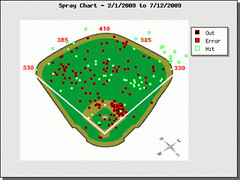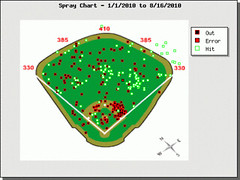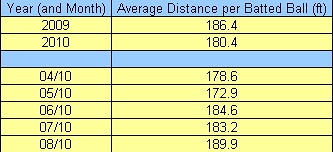The series continues.
CHICAGO CUBS
Number of First 10 Picks Signed: 9.
Highest Bonus Awarded: Hayden Simpson, Southern Arkansas, rhp, 16th overall.
College/HS Breakdown of 10 Highest Drafted Signees: 5 college, 2 HS, 3 JC.
Pitcher/Hitter Breakdown: 7/3.
Notable Performances Thus Far: The Cubs performances should serve as a reminder that using short-season statistics to make too many assumptions is problematic. This is because, in the limited time the draftees have been in the minor leagues, the middle-round picks are succeeding far more than the early rounders. While third-round college catcher Micah Gibbs has been a disaster, hitting .143/.229/.162 in 120 plate appearances, fifth-round outfielder Matthew Szczur was so good in the same league (.397/.439/.521) that he was promoted to full season ball. Where fourth-round JC lefty Hunter Ackerman has struggled in the complex league (2.21 WHIP!), eighth-round JC lefty Cameron Greathouse is getting ground balls (3.82 G/F) and strikeouts (9.0 K/9).
Thoughts: This was an undeniably strange draft by the Cubs, who signed just three players for more than $350,000. Tim Wilken has already thrown the gauntlet down for his first-round pick, comparing Simpson to Roy Oswalt on draft day. While they stuck their necks out with that pick, the other big investments in Reggie Golden and Ben Wells seem prudent. The team had a funny focus on smaller right-handers, perhaps seeing a market inefficiency that no one else did. While I like the team’s other picks (Golden, Szczur) quite a bit, it’s their ballsy strategy that bears paying attention to.
CINCINNATI REDS
Number of First 10 Picks Signed: 10.
Highest Bonus Awarded: Yasmani Grandal, Miami, c, 12th overall.
College/HS Breakdown of 10 Highest Drafted Signees: 6 college, 3 HS, 1 JC.
Pitcher/Hitter Breakdown: 5/5.
Notable Performances Thus Far: The team went with four college hitters early, and with the exception of Grandal, all have had a lot of time in the minors. Ryan LaMarre has been a little better than average (.353 wOBA) in the Midwest League, which is more than Devin Lohman (.314 wOBA) or Brodie Greene (.304 wOBA) are doing in the Pioneer and Carolina Leagues, respectively. We haven’t seen as much of the pitchers drafted, although former Oregon State ace Tanner Robles has done a nice job (3.85 FIP) in the difficult Pioneer League environment.
Thoughts: Grandal was a favorite of mine in the draft, and his selection adds another catcher to this system. If there is a worry about his game, I think the bat speed is probably more troubling than his arm strength. I didn’t find the three college hitters particularly inspiring, but then again, they weren’t really the next-best players signed: the team gave a half-million to high school outfielder Kyle Waldrop in the 12th round, and almost one million to sixth-round pick Drew Cisco. These guys add some nice depth, and star potential, to the draft behind Grandal.
HOUSTON ASTROS
Number of First 10 Picks Signed: 9.
Highest Bonus Awarded: Delino DeShields Jr, Georgia HS, 2B, 8th overall.
College/HS Breakdown of 10 Highest Drafted Signees: 6/4.
Pitcher/Hitter Breakdown: 5/5.
Notable Performances Thus Far: The team got its second and third pick, Mike Foltynewicz and Mike Kvasnicka, signed quickly, and both have had some good experience this summer. Foltynewicz has pitched better (4.26 FIP) than his 5.52 ERA indicates, while Kvasnicka has struggled with the bat while juggling three positions in the New York-Penn League. The most encouraging performances have come from second-round pick Vincent Velasquez (3.59 FIP) and fifth-round catcher Ben Heath, who has hit .271/.383/.516 over two leagues, including the South Atlantic League.
Thoughts: There was probably more pressure on the Astros to draft well — four of the first 58 picks, bad farm system — than any other team in baseball. They went for upside and potential, so it’s definitely too early to judge their haul. Kvasnicka’s early struggles are the most disconcerting, but easily written off given the defensive demands asked of him. And, I certainly wouldn’t be surprised if he’s not the best college hitter the team drafted, between Heath and Austin Wates. But the key for the draft will be the three top 60 high school guys, who come at an investment of more than $4 million.
MILWAUKEE BREWERS
Number of First 10 Picks Signed: 9.
Highest Bonus Awarded: Jimmy Nelson, Alabama, rhp, 64th overall.
College/HS Breakdown of 10 Highest Drafted Signees: 8/2.
Pitcher/Hitter Breakdown: 6/4.
Notable Performances Thus Far: It’s pretty easy to just check the Helena Brewers box score to judge how this draft class has done so far: four of the team’s first five signees are there. The best has been either third-round pitcher Tyler Thornburg, who has struck out 20 of the 47 batters he’s faced, or sixth-round bat Cody Hawn, hitting a cool .284/.384/.510. Nelson has been a mixed bag out of the bullpen (3.37 FIP, 4.58 ERA), while Matthew Miller has been unimpressive in the rotation. The team’s first hitter drafted, Hunter Morris, has hit for power nicely (.205 ISO), but his .344 wOBA means the rest of his game is pretty unrefined.
Thoughts: It’s hard to assign the Brewers a lot of blame for not signing first-round pick Dylan Covey, who was diagnosed with Type 1 diabetes, and opted to attend college close to home rather than sign with Milwaukee. There isn’t much the team could do about it, but truly, without Covey the team’s draft is safe and unexciting. Perhaps Morris or Hawn are the eventual replacement for Prince Fielder at first base (though they won’t be ready in time to make it a seamless transition), and only Thornburg has a large gap between his present abilities and ultimate ceiling. Plain and simple, this is a draft that needed a first rounder.
PITTSBURGH PIRATES
Number of First 10 Picks Signed: 6.
Highest Bonus Awarded: Jameson Taillon, Texas HS, rhp, 2nd overall.
College/HS Breakdown of 10 Highest Drafted Signees: 4 college, 3 HS, 3 JC.
Pitcher/Hitter Breakdown: 7/3.
Notable Performances Thus Far: Mel Rojas Jr. hit his 100 at-bat milestone yesterday in the New York-Penn League. While he’s showed little power (.060 ISO) and bad contact rates (25 K%), his patience and athleticism still grade out highly. On the same team, fifth-round pick Tyler Waldron has done a nice job with command and ground balls, but only 5.1 K/9. The majority of this draft class has not begun playing professionally yet.
Thoughts: This is great; this is a team putting their money where their mouth is, and showing a belief in the draft. $10 million is peanuts in the grand scheme of Major League spending, and it’s amazing how much talent it can bring in. In this draft, the Bucs signed two of the best high school pitchers to seven figure deals, and then gave five others at least $400K. It’s hard to imagine a scenario where the Pirates miss on their four big high school pitchers: Taillon, Stetson Allie, Nick Kingham, Ryan Hafner. And between Rojas, Drew Maggi and Jared Lakind, they might have snagged a future regular, too. This draft has great balance and a great budget. Win.
ST. LOUIS CARDINALS
Number of First 10 Picks Signed: 10.
Highest Bonus Awarded: Zack Cox, Arkansas, 3b, 25th overall.
College/HS Breakdown of 10 Highest Drafted Signees: 8/2.
Pitcher/Hitter Breakdown: 5/5.
Notable Performances Thus Far: The team’s first four picks haven’t started yet. The earliest that has is high school shortstop Sam Tuivailala, and he’s been overmatched. The team’s next five picks were signable college guys, and all have done predictably well in short-season ball. Lefties John Gast (0.50 ERA, 18 IP) and Dan Bibona (0.61 ERA, 14.2 IP) have been ridiculous, while the best of the offensive players has been catcher Cody Stanley, both for his offense (.394 wOBA) and defense (56 CS%). Neither Nick Longmire (.842 OPS) or Greg Garcia (.778 OPS) have been bad, either.
Thoughts: St. Louis signed 17 of the first 18 players they drafted, with the exception being Austin Wilson, who I think was insurance in case Zack Cox didn’t sign. Their draft is college heavy, but I think they definitely have a few big leaguers here. Jordan Swagerty should fly through the system and make the bullpen by 2012. Cox has some more volatility than I’d like from a college guy, but his potential is excellent. Tyrell Jenkins was one of my favorite high school guys in the class. The Cardinals did good here, and it’s a good thing, because the farm system needed some depth.
Favorite NL Central Draft: Pittsburgh. Least Favorite: Milwaukee.



